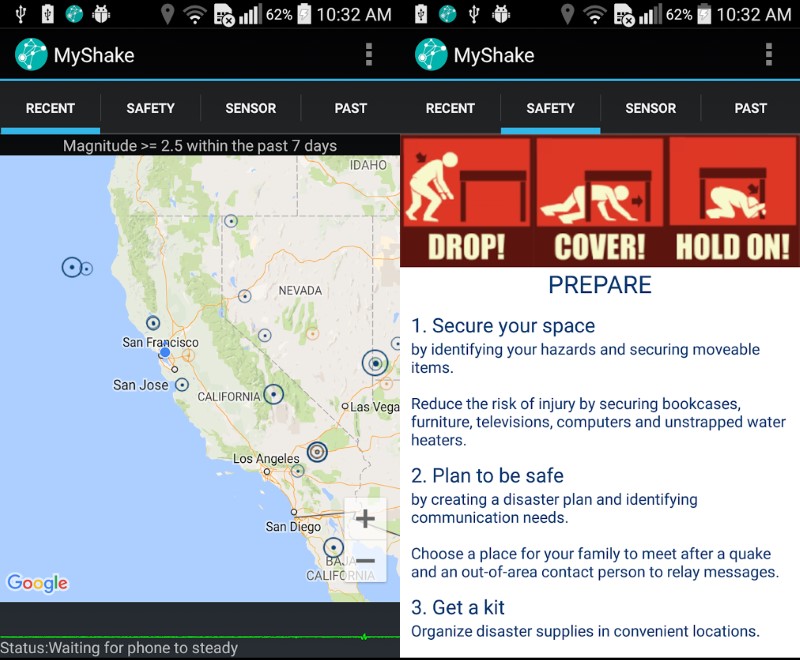New App Turns Android Smartphones Into Earthquake Detectors

With the help of a smartphone's accelerometer - the motion-detection instrument - the app, called MyShake taps a phone's ability to record ground shaking from an earthquake.
The android app, which can be downloaded from Google Play Store, runs in the background with little power, so that a phone's onboard accelerometers can record local shaking any time of the day or night.
For now, the app only collects information from the accelerometers, analyses it and, if it fits the vibrational profile of a quake, relays it and the phone's GPS coordinates to the Berkeley Seismological Laboratory at the University of California, Berkeley, for analysis.
However, once enough people are using it, the seismologists plan to use the data to warn people miles from ground zero that shaking is rumbling their way.
"MyShake cannot replace traditional seismic networks like those run by the US Geological Survey, UC Berkeley, the University of Washington and Caltech, but we think MyShake can make earthquake early warning faster and more accurate in areas that have a traditional seismic network, and can provide life-saving early warning in countries that have no seismic network," said the leader of the app project Richard Allen from the University of California, Berkeley.
A crowd-sourced seismic network may be the only option today for many earthquake-prone developing countries, such as Nepal or Peru, that have a sparse or no ground-based seismic network or early warning system, but do have millions of smartphone users.
"In my opinion, this is cutting-edge research that will transform seismology," UC Berkeley graduate student Qingkai Kong, who developed the algorithm at the heart of the app, said.
Smartphones can easily measure movement caused by a quake because they have three built-in accelerometers designed to sense the orientation of the phone for display or gaming.
While constantly improving in sensitivity for the benefit of gamers, however, smartphone accelerometers are far less sensitive than in-ground seismometers.
But they are sensitive enough to record earthquakes above a magnitude 5 -- the ones that do damage -- within 10 kilometres.
And what these accelerometers lack in sensitivity, they make up for in ubiquity. There are an estimated one billion smartphones worldwide, the researchers said.
In a paper published in the journal Science Advances, the researchers described the algorithm in the mobile app that analyses a phone's accelerometer data and distinguishes earthquake shaking from normal vibrations, such as walking, dancing or dropping the phone.
In simulated tests, the algorithm that the researchers developed successfully distinguished quakes from non-quakes 93 percent of the time.
For the latest tech news and reviews, follow Gadgets 360 on X, Facebook, WhatsApp, Threads and Google News. For the latest videos on gadgets and tech, subscribe to our YouTube channel. If you want to know everything about top influencers, follow our in-house Who'sThat360 on Instagram and YouTube.
Related Stories
- AI
- iPhone 16 Leaks
- Apple Vision Pro
- Oneplus 12
- iPhone 14
- Apple iPhone 15
- OnePlus Nord CE 3 Lite 5G
- iPhone 13
- Xiaomi 14 Pro
- Oppo Find N3
- Tecno Spark Go (2023)
- Realme V30
- Best Phones Under 25000
- Samsung Galaxy S24 Series
- Cryptocurrency
- iQoo 12
- Samsung Galaxy S24 Ultra
- Giottus
- Samsung Galaxy Z Flip 5
- Apple 'Scary Fast'
- Housefull 5
- GoPro Hero 12 Black Review
- Invincible Season 2
- JioGlass
- HD Ready TV
- Laptop Under 50000
- Smartwatch Under 10000
- Latest Mobile Phones
- Compare Phones
- Realme C65 5G
- iQOO Z9x
- iQOO Z9
- HMD Pulse
- HMD Pulse+
- HMD Pulse Pro
- Realme Narzo 70x 5G
- Realme Narzo 70 5G
- Dell Alienware X16 R2
- Lenovo IdeaPad Pro 5i
- Realme Pad 2 Wi-Fi
- Redmi Pad Pro
- boAt Storm Call 3
- Lava ProWatch Zn
- Samsung Samsung Neo QLED 8K Smart TV QN800D
- Samsung Neo QLED 4K Smart TV (QN90D)
- Sony PlayStation 5 Slim Digital Edition
- Sony PlayStation 5 Slim
- Lloyd 1.5 Ton 3 Star Inverter Split AC (GLS18I3FOSEW)
- Haier 1.5 Ton 3 Star Triple Inverter Split AC (HSU18K-PYSS3BN-INV)
















